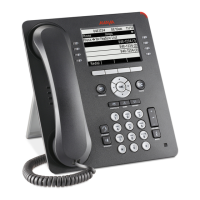Chapter 5: Troubleshooting
Resolving error conditions
There are four areas where installers can troubleshoot problems before seeking
assistance from the system or LAN administrator:
1. Check both the power and Ethernet wiring for the following conditions:
• Whether all components are plugged in correctly.
• Check LAN connectivity in both directions to all servers - DHCP, HTTP, HTTPS,
DEFINITY
®
/MultiVantage™.
• If the telephone is supposed to be powered from the LAN, ensure that the LAN
is properly administered and is compliant with IEEE 802.3af.
2. If you are using static addressing:
• Use the VIEW option to find the names of the files being used and verify that
these filenames match those on the HTTP/HTTPS server. See
Using the VIEW
craft procedure for troubleshooting on page 66 for more information. Check
the Avaya Web site to verify whether the correct files are being used.
• Use the ADDR option to verify IP Addresses. See
Changing IP address
information on page 42 for information.
3. If the deskphone is not communicating with the system (DHCP, HTTP, or Avaya
Media Server), make a note of the last message displayed, as described in
Installation error and status messages and/or Operational errors and status
messages.
Consult the system administrator. Sometimes problems with Communication
Manager - HTTP communications can be corrected by setting the HTTPPORT value
to 81.
4. If you expect the telephone to be IEEE-powered, verify with the LAN administrator
that IEEE power is indeed supported on the LAN.
H.323 Installation & Maintenance Guide R6.1 May 2011 65

